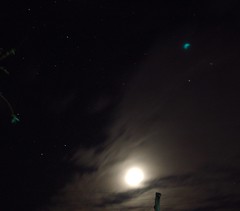Peru has stepped up efforts to monitor airports, sea ports and borders in light of the continuing threat from the swine flu inflicting Mexico and parts of the United States.
Category: "News"
Uru Chipaya face extinction through climate change [Featured]
Its members belong to what is thought to be the oldest surviving culture in the Andes, a tribe that has survived for 4,000 years on the barren plains of the Bolivian interior. But the Uru Chipaya, who outlasted the Inca empire and survived the Spanish conquest, are warning that they now face extinction through climate change.
Less than 13% of Arequipa vehicles meet emissions limits
Arequipa may be all kinds of beautiful, but their is an obvious problem with the quality of life there and you only need to step onto a busy street to see what it is.
Random inspections carried out of Arequipa’s vehicles found the less the 13% of them met limits set on carbon monoxide emissions.
Decontamination of Rimac River to cost more than $100 million
The Peruvian Times, read here, is reporting that a cleanup of the polluted Rímac river would cost upwards of $100 dollars and take 5 years.
A thorough and complete cleanup of Peru’s heavily polluted Rimac River could potentially cost more than $100 million and take up to five years, said Chaclacayo mayor and President of the Rimac River Mayors’ Association, Alfredo Valcárcel Cahen.
The Shipibos of the River Rimac
They used to live and the edge of an Amazonian river that was an unending source of life. But they came to Lima, and now they live on river that is a polluted source of illness and death. Far from their lands, their children no longer speak Shipibo and their customs are almost forgotten.
Lord of Ucupe: “King of Bling” Tomb Sheds Light on Ancient Peru [Featured]
I wrote some time ago about the stunning archaeological find at a dig led by Canadian Steve Bourget of the University of Texas. Here is the follow-up by National Geographic News:
Fujimori’s mega-trial draws to a close [Featured]
The BBC’s Dan Collyns sums up the trial of President-come-Dictator Alberto Fujimori. He has been found guilty on human-rights abuse charges stemming from Peru’s so-called “dirty war” of the early 1990s, in which 70,000 people died as Maoist guerillas ravished the country.
Fujimori served as Peru’s president from 1990 to 2000, at the height of the country’s war with the radical Maoist Shining Path guerrillas and the Tupac Amaru Revolutionary Movement. He is accused of authorizing slayings and kidnappings that were carried out by paramilitary death squads in 1991 and 1992 during what is often referred to as Peru’s “dirty war.”
Lima city districts at war over boundaries
One thing you can say about living in Peru is that there’s never dull moment. Things happen here that just don’t happen elsewhere… like Lima city districts fighting for control of territory and tax payers.
Believe it or not, this involves clashes between each district’s auxiliary police and residents trying to gain footholds in disputed territories with their security posts, and mayors accusing each other of threatening behaviour. We can only hope things don’t escalate to having standing armies invading neighbouring districts in bloody imperial conquest.
Construction company denies destroying Inca wall
It has been two months since construction began on a 5-star Marriott hotel in the Andean city of Cusco, two blocks from the historic Plaza de Armas and its Inca architecture. Charged with constructing the building, Peruvian company Inversiones La Rioja has been accused of destroying an Inca wall in the process.
Local leader of a community group that protects the monuments in the area, César Bocángel, presented his complaint to authorities, with evidence that Inca blocks had been taken to a local dump with rubble from the construction process.
Maca sunscreen?
The past year has been a great year for Maca. We have discovered among its many properties that the Andean root has a fantastic ability to combat osteoporosis, now there is news that maca may become a key and natural ingredient in modern sunscreens.
Grown above 4 thousands metres of altitude, in a land of extremes – including a strong unrelenting sun – perhaps its little wonder that maca has a strong resistance to high levels of UV light.
The historic Yavarí sails again
The Yavarí Project have signed a 10 year concession to Yavarí Voyages that will see the old ship finally do what it was meant to – ferry passengers around Lake Titicaca.
Built in England in 1862, the Yavarí comprises of 2,766 pieces that arrived in Arica – then in southern Peru – to begin the long journey by hundreds of mules to Lake Titicaca to be reassembled. More than a century later, it was discovered in a state of disrepair by a British woman named Meriel Larken.
Houses on the Rimac could be washed away at any moment
Since mass migration from rural Peru expanded the city of Lima to its current size, people have been building on land they really shouldn’t have been. People built their new homes on land that wasn’t theirs but were eventually issued titles too when they became entrenched and established. A process that in Peru is called “invading”, this is how most of the poorer districts of Lima got started – districts that now have sewage and water systems, streets, hospitals restaurants. Sometimes, the homes of the newly arrived where built not only on land that wasn’t theirs, but on land where it isn’t safe to do so. You see this all the time with shacks clinging onto steep sandy cliffs.
Just north of the colonial centre of Lima, a few blocks walk from Av. Argentina and Las Malvinas, are several disorganised blocks of houses on part of the flood plain of the river Rimac.










![Novalima in London [Featured]](http://farm3.static.flickr.com/2311/1508319950_4fede310ba_m.jpg)